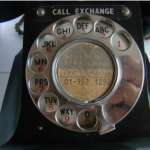Another in the series of occasional writings into things that we take for granted but that have become classic icons, this time concentrates on the design that revolutionised our daily communication with one another; I give you the Bakelite Telephone.
Designed in collaboration by Swedish-Norwegian designers, this telephone dates back to 1925 and set the standard for how a modern plastic phone should look. Designed and developed by Erikrisk Bureau A/S but produced by AB Alpha of Sundbyberg, Sweden, Ericson was looking for a phone to use for automatic switching in conjunction with its 500 switch system and employed this soft material called Bakelite and designer Johan Christian Bjerknes produced the design we see today in partnership with artist Jean Heiberg.
For the telephone manufacturers the move from plate to Bakelite was a total revolution. It has been suggested that the time needed to make the casing was reduced from one week to around seven minutes. That is about how long it took for the hot moulding compound to cure and then, when the Bakelite press spit the casing out, it was ready to assemble over all components on the bottom metal plate. In many ways Bakelite was the perfect material for telephones at the time. Basically they could be moulded into any shape possible, even the soft streamline shapes preferred. The material is homogenous, evenly coloured and hard, with a lovely lustre. It is also comfortable to hold, does not draw moisture and is easy to keep clean, a contributing factor to its early use for both telephone receivers and toilet seats. In fact, colour was the only problem. For technical reasons, black was the only possible colour, or perhaps some related drab nuances.
The US company Automatic Electric had made a Bakelite telephone as early as 1925 where everything but the metal cradle was made in plastic. The new Ericsson telephone was completely formed in Bakelite with the cradle integrated in the actual casing. The integrated sculptural form departed from the more additive, engineer oriented design of the plate era. Contemporary commentators praised the Ericsson’s phone for its simple, stylistically pure form, making it the favourite of functionalistic designers and a natural for the homes of the Swedish Welfare State. In many contemporary pictures it stands in sole majesty on the hall table, often with the receiver held by the house’s mistress.
The Bakelite telephone initiated a closer collaboration between the Telegrafverket, precursor to today’s Swedish Telecom, and Ericsson. The authority had its own manufacturing right and in 1933 the phone became standard on the Swedish telenet with the model number m33. Prior to that time, however, Ericsson had succeeded in selling it to several larger foreign networks with its largest breakthrough being the 1936 acceptance as the standard for the comprehensive British General Post Office system. It also became an important prototype for the giant Bell Group’s new 300-model that in 1937 began to replace the unpractical, standing candle holder telephones prevalent in the US. In 1947 the Bakelite telephone was redesigned, using more plastic and American design. One change was that the previous metal finger dial was replaced by one in impact resistant thermoplastic.
Resplendent with its period number the phone featured the classic letter numeric dial design
The phone you see here is my own, purchased some 15 years ago featuring the metal dialing wheel. Once prevalent in every home these classics seem to have disappeared in recent years and yet they have a number of features that remain beautiful today. Things we took for granted have over a period of time become enchanting and mine can still be used on current networks. The things I particularly like about this phone are the following features:
The sound of the dialing mechanism has is a beautiful metallic sound which sadly disappeared with modern phones.
The Bell tone has never been successfully replaced and some modern mobile phones mimic the sound.
The braided lead is typical of the design at that time, and this particular phone featured the useful pull out tray for those numbers you used all the time to be stored in.
This phone came to prominence featuring in some major TV programs such as Dixon of Dock Green and of course the iconic fire station unit on children’s progamme Trumpton.
Whilst not used on a daily basis, ours has become a feature ornament of our lounge. As to value, I have no idea. I expect it has gone up since it was purchased but like so many items that are marked as period, the beauty is in the eye of the beholder.
Justifiably perfect for The Old and Rusty section of the Easy Balloons website, I give you the classic Bakelite telephone.
Steve Roake

